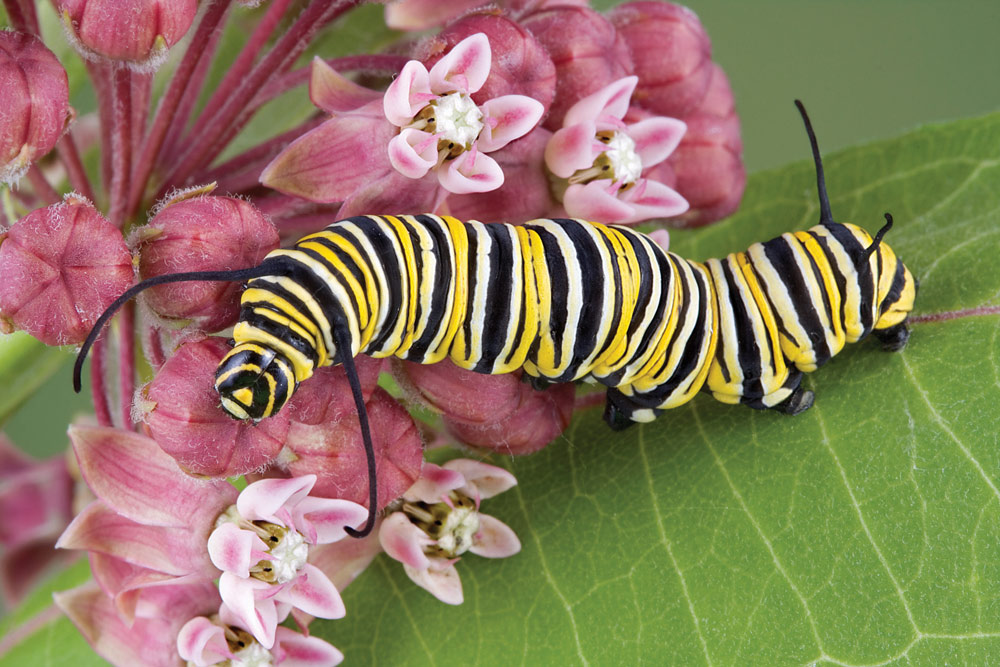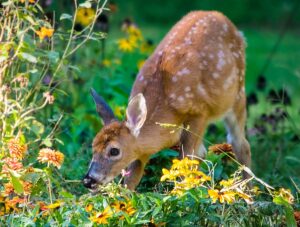Imagine eating only one type of food for your entire life, and your sole survival depends on being able to find it. This is a challenge monarch butterflies face every day. The monarch caterpillar feeds exclusively on milkweed plants, contributing to a unique relationship between the two species: If no milkweeds are growing in the landscape, no monarch butterflies are found.
Twenty-two species of milkweed are native to Illinois. All grow in a variety of habitats easily replicated in your own backyard, allowing you to grow the plants that support monarchs, our state butterfly.
Monarchs use chemical and visual cues from their sensory organs to identify milkweed plants. The females typically lay eggs on milkweed leaves ensuring young larvae have an immediate food source once they hatch. Larvae (caterpillars) eat foliage for about two weeks, eating about 200 times their birth weight. With energy stored, they find a nearby spot to form into a chrysalis.
This transformation occurs in 10–14 days. When the protective shell left from the chrysalis is shed, an adult monarch butterfly emerges. Hungry adults will visit the milkweed flowers for nectar and frequent other nearby high nectar-producing flowers.
Milkweeds are herbaceous perennials, dying down to the ground each winter and regrowing foliage each spring. Most milkweed species contain a milky, white sap that exudes when the plant is cut open. All parts of the plant contain toxic compounds which the monarch butterfly has adapted to ingest.
While feeding on milkweed, caterpillars will consume enough of the toxic compounds to deter birds (and small mammals) from eating them as adult butterflies. The compounds are present at high enough rates to be both distasteful and poisonous to predators.

Milkweed flowers contain high levels of nectar and are a favorite food source for local pollinators. Flower colors vary from species to species but can be pink, purple, red, white, green or orange. Mature flowers turn into pods of seeds that are attached to white, fluffy floss which is easily dispersed throughout the landscapes by wind.
Common milkweed is a weedy species despised by many gardeners and farmers. There are alternatives to this milkweed species which support the monarch in a variety of habitats. A huge patch of milkweed is not necessary to benefit monarchs, a small patch will suffice. Consider planting multiple species for season-long support of monarchs because each species has a distinct phenology and bloom time.
Butterfly milkweed has striking orange flowers that make it an ornamental garden favorite. Many gardeners do not realize it is milkweed. It blooms from May through September, growing 2-3 feet tall and grows best in full sun and well-drained soils.
Prairie milkweed, also called Sullivant’s milkweed, is found in moist to wet prairies in Illinois. It is often mistaken for common milkweed, but has smooth, succulent-like leaves and is not aggressive in the landscape. It makes a great addition to any perennial flower garden with its large leaves reaching 3-4 feet tall.
Swamp milkweed is found natively growing in swampy areas, wet ditches and meadows throughout Illinois. The pink blooms appear June through August atop 5-foot lance-shaped foliage. This plant prefers full sun and moist, well-drained soils.
Poke milkweed grows best in shade or partial sun, in moist, well-drained soils. It reaches 2-6 feet tall, depending on growing conditions. The white drooping blooms appear June through August.
Whorled milkweed has linear leaves that grow best in full sun and moderate to dry conditions. It blooms later than most milkweed, July through September. It creates 1–2-foot-tall drifts of fine, delicately textured foliage.










